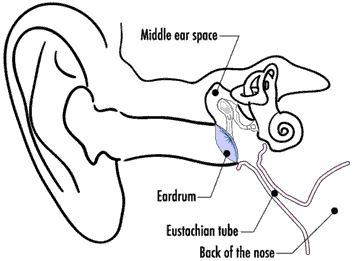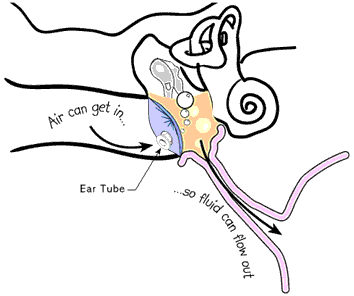Ear Tubes
Article Translations: (Spanish) (Hmong) (Somali)
Why does my child need ear tubes?
Ear tubes are recommended for children who either get lots of ear infections or have fluid behind the eardrum that doesn’t go away. Both of these problems are most common between the ages of 6 months and 3 years, although older children sometimes have these problems too.
How do ear tubes work?
During an ear infection, fluid builds up behind the eardrum in a place called the middle ear space. Normally, when the ear infection has run its course the fluid drains out of the middle ear into the back of the nose through the body’s natural drainage tube called the Eustachian Tube (yoo-STAY-shun).
Sometimes this fluid doesn’t go away because the Eustachian Tube remains swollen and can’t open. Fluid trapped behind the eardrum causes a hearing loss because it prevents the eardrum from vibrating normally.
Ear tubes are small plastic or metal tubes that are surgically inserted into the eardrum (also called the tympanic membrane).
Ear tubes also allow air to get into the middle ear. Just like the big bubbles in the water tank on top of a water cooler, air needs to get into the middle ear in order for the fluid to drain out. Over time this “ventilation” helps to decrease swelling in the Eustachian Tube and allows it to function normally again. This is why ear tubes are sometimes called ventilation tubes or pressure equalization tubes (PE tubes for short).
How are ear tubes put in?
Ear tubes are put in by an ears, nose, and throat surgeon. Using a microscope, a small incision is made in the eardrum. The tube is then placed through this hole.

Since the tubes are very small, this is a delicate operation. Because children cannot hold still for this procedure it is performed in the operating room under general anesthesia. In this day and age, general anesthesia is very safe and your child will be carefully monitored during the procedure. You will have a chance to talk with the anesthesiologist on the day of surgery to discuss any questions you may have about the anesthesia.
Are there any instructions I need to follow before surgery?
Your child must have a physical examination by his or her pediatrician or family doctor within 30 days before surgery to make sure he or she is in good health. The doctor you see needs to complete the History and Physical form provided by our office. You must bring the completed form with you the day of surgery.
For your child's safety, it is very important that he or she have an empty stomach when anesthesia is given. Please follow Children’s Hospitals’ Eating and Drinking Guidelines. If you do not follow these guidelines, your child's surgery will be cancelled.
What can I expect after surgery?
The procedure itself usually takes no more than 10 or 15 minutes. Your child will wake up in the recovery room after surgery. This usually takes no more than 15 to 30 minutes. When your child is awake, he or she will be taken to the discharge area to complete the recovery. You can be with your child once he or she has been transferred to the discharge area.
- Fevers up to 102.0 F are considered normal after surgery. Call your provider for fevers over 102.0 F that do not come down with acetaminophen (Tylenol) and/or Ibuprofen
- There may be a watery, mucus-like, or bloody discharge from either ear for 2 or 3 days. Your doctor may give you a prescription for ear drops to use after surgery to help control the drainage and prevent the ear tube from clogging. You should keep any leftover drops in your medicine cabinet to use for future episodes of ear drainage.
- Your child may have an earache the day of surgery. This is caused by pressure changes in the ear and/or hearing louder sounds than he or she is used to. You can treat this short term discomfort with Tylenol® (acetaminophen) or Children's Motrin® (ibuprofen).
- You will get a Discharge Instructions sheet before you go home which will indicate how much medicine to give and how often.
- You can expect your child to be back to his or her regular diet and activities within 24 hours after surgery.
Ear drainage after ear tubes
Ear infections are still possible with ear tubes and you will notice drainage coming from the ears. If drainage is noted in one or both of your child’s ears, your ENT provider will give you a prescription for antibiotic ear drops.
If ear drainage is noted, you can start the antibiotic ear drops at home and let the ENT team know that you have started ear drops via MyChildrens Portal or telephone the ENT clinic at 612-874-1292 on the next business day (Monday through Friday 8 a.m. to 4:30 p.m.)
Please also contact the ENT clinic during normal business hours if the ear drainage is still present after a full 7 days of ear drops OR for back to back episodes of ear drainage as we may need to see your child back in the clinic for additional medical management.
Questions?
The information provided in this brochure is not specific to your child. This information is provided as a service to our patients. The information is for educational and informational purposes only and should NOT be used as a substitute for the advice of your child’s physician.
If you have any questions, please call Children’s ENT and Facial Plastic Surgery Clinic.
Reviewed 10/2022
This page is not specific to your child, but provides general information on the topic above. If you have any questions, please call your clinic. For more reading material about this and other health topics, please call or visit Children's Minnesota Family Resource Center library, or visit www.childrensmn.org/educationmaterials.
© 2024 Children's Minnesota
